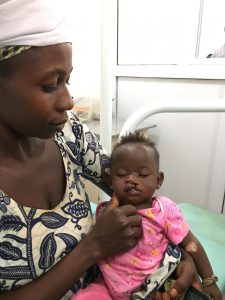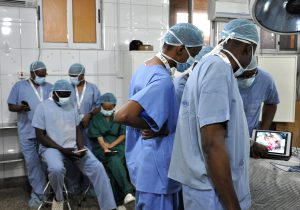
When Dr. Richard Hopper, surgical director of Seattle Children’s Craniofacial Center, and his team of experts identify a problem, they won’t stop thinking about ways to solve it. Such was the case when they invented a device to help teach doctors in Africa how to perform cleft lip and palate surgery.
Cleft lip and cleft palate are birth defects that occur when part of a child’s lip or roof of the mouth don’t form properly, leaving a gap, or cleft. Cleft lip and palate are some of the most common birth defects in the U.S., occurring in about one in 4,000 babies. In Africa, the statistics are similar; however, the lack of medical care and shortage of surgeons to repair the birth defects can cause a cascade of problems for newborns, including malnutrition, social isolation and premature death.
Solving a problem through innovation
“When I visited Ghana for the first time, we found one of the greatest needs was in engaging and training more African doctors to perform the cleft lip and palate surgery,” said Hopper. “It’s a very technical surgery and you need a lot of education before you can do it safely.”
The problem was clear: a lack of surgeons who could safely and effectively repair the large numbers of babies born with cleft lip and palates each year. The solution was not clear, but the Seattle team was determined to find a solution.
“The challenge was to try to find a device that would let an African surgeon in Africa do a cleft palate surgery safely with all the needs that a surgeon in North America would have,” said Hopper. “The device not only needed to help the surgeon doing the repair, but also to teach a large number of trainees in the room at the same time”.
Such a device needed to be tough, inexpensive and easy to fix with interchangeable parts.
And so, the Partners in African Cleft Training (PACT) Retractor was born. The retractor was designed to be placed in a child’s mouth to gently retract the cheeks, tongue and gums, so that a surgeon would have enough room to operate inside a child’s tiny mouth, while also allowing for surgical trainees in the room to watch the surgery while it was happening so they could learn to do it themselves.
Training with technology

Hopper and his team had worked with their African partners in Sub-Saharan Africa for the past decade, so they had a good idea of what technology would work, and what would not. They needed something that would work in an environment where electricity blackouts are common and Wi-Fi networks are not available. Everything the team used in Seattle was either too expensive or wouldn’t be able to be maintained.
That’s when the idea of the borescope entered the picture. A borescope is a small optical device that is flexible and rugged, typically used by mechanics and engineers to look in tight spaces. It was the perfect answer. The device was strong, it ran on standard batteries and it provided its own LED light to help the surgeon see inside the mouth. Although Wi-Fi is rare in Sub-Saharan Africa, cell phones are common, and the borescope was able to transmit video to phones of surgical trainees so they could watch the surgery.
“It took us almost 10 years not just to come up with the device, but to really learn from our African friends what would work in Africa,” said Hopper.
Since 2007, Hopper and Seattle Children’s Craniofacial team have been traveling to Africa to help train surgeons to treat cleft lip and palate. To date, they have successfully trained more than 90 African providers from seven different African nations, including Ghana, Ethiopia and Nigeria.
To learn more about the PACT Retractor and other life-saving innovations developed by Seattle Children’s researchers and providers, watch “Health Innovations Impacting Kids Worldwide.”

